Impacts of Atmospheric and Anthropogenic Factors on Microbiological Pollution of the Recreational Coastal Beaches Neighboring Shipping Ports
Abstract
:1. Introduction
2. Materials and Methods
2.1. Study Areas
2.2. Sample Collection
2.2.1. Shipping Ports
2.2.2. Coastal Recreational Waters
2.3. Microbiological Analysis
2.4. Atmospheric and Anthropogenic Factors
2.4.1. Population
2.4.2. Tourists
2.4.3. Ballast Water
2.4.4. Precipitation and Solar Radiation
2.5. Bathing Water Quality
2.6. Statistical Analysis
2.7. Numerical Modeling of the Pollution Source in the Rijeka Area
3. Results
3.1. Microbial Contamination of the Two Ports
3.2. Comparison of the Microbial Contamination in Ports with the Surrounding and Wider Areas
3.3. Assessment of the Microbiological Quality of Seawater in the Surrounding and Wider Area
3.4. Atmospheric and Anthropogenic Influences on Seawater Quality in the Area Surrounding Investigated Ports
3.5. Numerical Modeling of the Pollution Source in the Rijeka Area
4. Discussion
5. Conclusions
Author Contributions
Funding
Institutional Review Board Statement
Informed Consent Statement
Data Availability Statement
Acknowledgments
Conflicts of Interest
References
- Martínez, M.L.; Intralawan, A.; Vázquez, G.; Pérez-Maqueo, O.; Sutton, P.; Landgrave, R. The coasts of our world: Ecological, economic and social importance. Ecol. Econ. 2007, 63, 254–272. [Google Scholar] [CrossRef]
- European Union. Directive 2006/7/EC of the European Parliament and of the Council of 15 February 2006 Concerning the Management of Bathing Water Quality and Repealing Directive 76/160/EEC; Official Journal of the European Union: Maastricht, The Netherlands, 2006. [Google Scholar]
- Bonadonna, L.; Briancesco, R.; Suffredini, E.; Coccia, A.; Della Libera, S.; Carducci, A.; Verani, M.; Federigi, I.; Iaconelli, M.; Bonanno Ferraro, G.; et al. Enteric viruses, somatic coliphages and Vibrio species in marine bathing and non-bathing waters in Italy. Mar. Pollut. Bull. 2019, 149, 110570. [Google Scholar] [CrossRef] [PubMed]
- Curiel-Ayala, F.; Quiñones-Ramírez, E.I.; Pless, R.C.; González-Jasso, E. Comparative studies on Enterococcus, Clostridium perfringens and Staphylococcus aureus as quality indicators in tropical seawater at a Pacific Mexican beach resort. Mar. Pollut. Bull. 2012, 64, 2193–2198. [Google Scholar] [CrossRef]
- Mohammed, R.L.; Echeverry, A.; Stinson, C.M.; Green, M.; Bonilla, T.D.; Hartz, A.; McCorquodale, D.S.; Rogerson, A.; Esiobu, N. Survival trends of Staphylococcus aureus, Pseudomonas aeruginosa, and Clostridium perfringens in a sandy South Florida beach. Mar. Pollut. Bull. 2012, 64, 1201–1209. [Google Scholar] [CrossRef] [PubMed]
- Sabino, R.; Rodrigues, R.; Costa, I.; Carneiro, C.; Cunha, M.; Duarte, A.; Faria, N.; Ferreira, F.C.; Gargaté, M.J.; Júlio, C.; et al. Routine screening of harmful microorganisms in beach sands: Implications to public health. Sci. Total Environ. 2014, 472, 1062–1069. [Google Scholar] [CrossRef] [PubMed]
- Soto-Varela, Z.E.; Rosado-Porto, D.; Bolívar-Anillo, H.J.; Pichón González, C.; Granados Pantoja, B.; Estrada Alvarado, D.; Anfuso, G. Preliminary Microbiological Coastal Water Quality Determination along the Department of Atlántico (Colombia): Relationships with Beach Characteristics. J. Mar. Sci. Eng. 2021, 9, 122. [Google Scholar] [CrossRef]
- Grbčić, L.; Družeta, S.; Mauša, G.; Lipić, T.; Lušić, D.V.; Alvir, M.; Lučin, I.; Sikirica, A.; Davidovi’c, D.; Travas, V.; et al. Coastal water quality prediction based on machine learning with feature interpretation and spatio-temporal analysis. arXiv 2021, arXiv:2107.03230. [Google Scholar]
- Vukić Lušić, D.; Kranjčević, L.; Maćešić, S.; Lušić, D.; Jozić, S.; Linšak, Ž.; Bilajac, L.; Grbčić, L.; Bilajac, N. Temporal variations analyses and predictive modeling of microbiological seawater quality. Water Res. 2017, 119, 160–170. [Google Scholar] [CrossRef]
- Ahmed, W.; Payyappat, S.; Cassidy, M.; Harrison, N.; Marinoni, O.; Besley, C. Prevalence and abundance of traditional and host-associated fecal indicators in urban estuarine sediments: Potential implications for estuarine water quality monitoring. Water Res. 2020, 184, 116109. [Google Scholar] [CrossRef]
- Luna, G.M.; Manini, E.; Turk, V.; Tinta, T.; D’Errico, G.; Baldrighi, E.; Baljak, V.; Buda, D.; Cabrini, M.; Campanelli, A.; et al. Status of faecal pollution in ports: A basin-wide investigation in the Adriatic Sea. Mar. Pollut. Bull. 2019, 147, 219–228. [Google Scholar] [CrossRef]
- Weiskerger, C.J.; Brandão, J.; Ahmed, W.; Aslan, A.; Avolio, L.; Badgley, B.D.; Boehm, A.B.; Edge, T.A.; Fleisher, J.M.; Heaney, C.D.; et al. Impacts of a changing earth on microbial dynamics and human health risks in the continuum between beach water and sand. Water Res. 2019, 162, 456–470. [Google Scholar] [CrossRef] [PubMed]
- Wheeler Alm, E.; Burke, J.; Spain, A. Fecal indicator bacteria are abundant in wet sand at freshwater beaches. Water Res. 2003, 37, 3978–3982. [Google Scholar] [CrossRef]
- WHO. Guidelines on Recreational Water Quality. Volume 1: Coastal and Fresh Waters. Licence: CC BY-NC-SA 3.0 IGO; WHO: Geneva, Switzerland, 2021. [Google Scholar]
- Cabrini, M.; Cerino, F.; De Olazabal, A.; Di Poi, E.; Fabbro, C.; Fornasaro, D.; Goruppi, A.; Flander-Putrle, V.; Francé, J.; Gollasch, S.; et al. Potential transfer of aquatic organisms via ballast water with a particular focus on harmful and non-indigenous species: A survey from Adriatic ports. Mar. Pollut. Bull. 2019, 147, 16–35. [Google Scholar] [CrossRef]
- Drake, L.A.; Doblin, M.A.; Dobbs, F.C. Potential microbial bioinvasions via ships’ ballast water, sediment, and biofilm. Mar. Pollut. Bull. 2007, 55, 333–341. [Google Scholar] [CrossRef]
- IMO. International Convention for the Control and Management of Ships’ Ballast Water and Sediments; International Maritime Organization: London, UK, 2004. [Google Scholar]
- Chiaretti, G.; Onorati, F.; Borrello, P.; Orasi, A.; Mugnai, C. Coastal microbial quality of surface sediments in different environments along the Italian coast. Environ. Sci. Process. Impacts 2014, 16, 2165–2171. [Google Scholar] [CrossRef] [PubMed]
- Dheenan, P.S.; Jha, D.K.; Das, A.K.; Vinithkumar, N.V.; Devi, M.P.; Kirubagaran, R. Geographic information systems and multivariate analysis to evaluate fecal bacterial pollution in coastal waters of Andaman, India. Environ. Pollut. 2016, 214, 45–53. [Google Scholar] [CrossRef] [PubMed]
- Edge, T.A.; Boyd, R.J.; Shum, P.; Thomas, J.L. Microbial source tracking to identify fecal sources contaminating the Toronto Harbour and Don River watershed in wet and dry weather. J. Great Lakes Res. 2021, 47, 366–377. [Google Scholar] [CrossRef]
- Ng, C.; Le, T.H.; Goh, S.G.; Liang, L.; Kim, Y.; Rose, J.B.; Yew-Hoong, K.G. A Comparison of Microbial Water Quality and Diversity for Ballast and Tropical Harbor Waters. PLoS ONE 2015, 10, e0143123. [Google Scholar] [CrossRef] [PubMed]
- Sciarrillo, R.; Zuzolo, D.; Cicchella, D.; Iannone, F.; Cammino, G.; Guarino, C. Contamination and ecological risk assessment of the seaport of Naples (Italy): Insights from marine sediments. J. Geochem. Explor. 2020, 210, 106449. [Google Scholar] [CrossRef]
- Wong, Y.S.; Tam, N.F.Y.; Lau, P.S.; Xue, X.Z. The toxicity of marine sediments in Victoria Harbour, Hong Kong. Mar. Pollut. Bull. 1995, 31, 464–470. [Google Scholar] [CrossRef]
- David, M.; Penko, L.; Zupančič, G.; Gosar, L. Ballast Water Discharge Assessment Methods and Analysis of Ballast Discharge Patterns in the Adriatic Area (Final Report). BALMAS Project. Work Package 4. Activity 4.2, Slovenia; ResearchGate: Berlin, Germany, 2016; p. 175. [Google Scholar]
- Kraus, R.; Travizi, A.; Jaklin, A.; Iveša, L.; Nerlović, V.; Mikac, B.; Marić Pfannkuchen, D.; Supić, N.; Đakovac, T.; Precali, R.; et al. PBS Report for Port of Pula. (Final Report). BALMAS Project. Work Package 5. Activity 5.1, Rovinj, Croatia; ResearchGate: Berlin, Germany, 2016; p. 122. [Google Scholar]
- Kraus, R.; Travizi, A.; Jaklin, A.; Iveša, L.; Nerlović, V.; Mikac, B.; Marić Pfannkuchen, D.; Supić, N.; Đakovac, T.; Precali, R.; et al. PBS Report for Port of Rijeka. (Final Report). BALMAS Project. Work Package 5. Activity 5.1, Rovinj, Croatia; ResearchGate: Berlin, Germany, 2016; p. 116. [Google Scholar]
- The Council of the European Union. Council Directive 98/83/EC of 3 November 1998 on the Quality of Water Intended for Human Consumption; The Council of the European Union: Brussels, Belgium, 1998. [Google Scholar]
- Efstratiou, M.A.; Mavridou, A.; Richardson, C. Prediction of Salmonella in seawater by total and faecal coliforms and Enterococci. Mar. Pollut. Bull. 2009, 58, 201–205. [Google Scholar] [CrossRef] [PubMed]
- Nassri, I.; Tahri, L.; Saidi, A.; Ameur, N.; Fekhaoui, M.R. Prevalence, diversity and antimicrobial resistance of Salmonella enterica and Pseudomonas aeruginosa isolates from spring water in a rural area of northwestern Morocco. Biodiversitas 2021, 22, 3. [Google Scholar] [CrossRef]
- Croatian Bureau of Statistic. CBS Databases. 2022. Available online: https://www.dzs.hr (accessed on 8 June 2022).
- IMO. International Maritime Organization. 2022. Available online: https://www.imo.org/en/MediaCentre/HotTopics/Pages/Implementing-the-BWM-Convention.aspx (accessed on 25 May 2022).
- CMHS. Croatian Meteorological and Hydrological Service. 2022. Available online: https://meteo.hr/index_en.php (accessed on 5 June 2022).
- SOLCAST. Solar Irradiance Data. 2022. Available online: https://solargis.com/ (accessed on 5 June 2022).
- Mance, D.; Mance, D.; Vukić Lušić, D. Environmental isotope O-18 in coastal karst spring waters as a possible predictor of marine microbial pollution. Acta Adriat. 2018, 59, 3–16. [Google Scholar] [CrossRef]
- Topić, N.; Cenov, A.; Jozić, S.; Glad, M.; Mance, D.; Lušić, D.; Kapetanović, D.; Mance, D.; Vukić Lušić, D. Staphylococcus aureus-An Additional Parameter of Bathing Water Quality for Crowded Urban Beaches. Int. J. Environ. Res. Public Health 2021, 18, 5234. [Google Scholar] [CrossRef]
- Noble, R.T.; Moore, D.F.; Leecaster, M.K.; McGee, C.D.; Weisberg, S.B. Comparison of total coliform, fecal coliform, and enterococcus bacterial indicator response for ocean recreational water quality testing. Water Res. 2003, 37, 1637–1643. [Google Scholar] [CrossRef]
- Skanavis, C.; Yanko, W.A. Clostridium perfringens as a potential indicator for the presence of sewage solids in marine sediments. Mar. Pollut. Bull. 2001, 42, 31–35. [Google Scholar] [CrossRef]
- Burkhardt, W.; Calci, K.R.; Watkins, W.D.; Rippey, S.R.; Chirtel, S.J. Inactivation of indicator microorganisms in estuarine waters. Water Res. 2000, 34, 2207–2214. [Google Scholar] [CrossRef]
- Kraus, R.; Grilli, F.; Supić, N.; Janeković, I.; Brailo, M.; Cara, M.; Cetinić, A.B.; Campanelli, A.; Cozzi, S.; D’Adamo, R.; et al. Oceanographic characteristics of the Adriatic Sea—Support to secondary HAOP spread through natural dispersal. Mar. Pollut. Bull. 2019, 147, 59–85. [Google Scholar] [CrossRef]
- Karbasdehi, V.N.; Dobaradaran, S.; Nabipour, I.; Ostovar, A.; Arfaeinia, H.; Vazirizadeh, A.; Mirahmadi, R.; Keshtkar, M.; Ghasemi, F.F.; Khalifei, F. Indicator bacteria community in seawater and coastal sediment: The Persian Gulf as a case. J. Environ. Health Sci. Eng. 2017, 15, 6. [Google Scholar] [CrossRef] [Green Version]
- Kucuksezgin, F.; Tolga Gonul, L.; Pazi, I.; Kacar, A. Assessment of seasonal and spatial variation of surface water quality: Recognition of environmental variables and fecal indicator bacteria of the coastal zones of Izmir Bay, Eastern Aegean. Reg. Stud. Mar. Sci. 2019, 28, 100554. [Google Scholar] [CrossRef]
- Davies-Colley, R.J.; Bell, R.G.; Donnison, A.M. Sunlight Inactivation of Enterococci and Fecal Coliforms in Sewage Effluent Diluted in Seawater. Appl. Environ. Microbiol. 1994, 60, 2049–2058. [Google Scholar] [CrossRef] [PubMed] [Green Version]
- Fujioka, R.S.; Hashimoto, H.H.; Siwak, E.B.; Young, R.H. Effect of sunlight on survival of indicator bacteria in seawater. Appl. Environ. Microbiol. 1981, 41, 690–696. [Google Scholar] [CrossRef] [Green Version]
- Jozić, S.; Morović, M.; Šolić, M.; Krstulović, N.; Ordulj, M. Effect of solar radiation, temperature and salinity on the survival of two different strains of Escherichia coli. Fresenius Environ. Bull. 2014, 23, 1852–1859. [Google Scholar]
- Sinton, L.; Davies-Colley, R.; Bell, R. Inactivation of enterococci and fecal coliforms from sewage and meatworks effluents in seawater chambers. Appl. Environ. Microbiol. 1994, 60, 2040–2048. [Google Scholar] [CrossRef] [PubMed] [Green Version]
- Perkins, T.L.; Clements, K.; Baas, J.H.; Jago, C.F.; Jones, D.L.; Malham, S.K.; McDonald, J.E. Sediment composition influences spatial variation in the abundance of human pathogen indicator bacteria within an estuarine environment. PLoS ONE 2014, 9, e112951. [Google Scholar] [CrossRef] [PubMed]
- Hassard, F.; Gwyther, C.L.; Farkas, K.; Andrews, A.; Jones, V.; Cox, B.; Brett, H.; Jones, D.L.; McDonald, J.E.; Malham, S.K. Abundance and Distribution of Enteric Bacteria and Viruses in Coastal and Estuarine Sediments-a Review. Front. Microbiol. 2016, 7, 1692. [Google Scholar] [CrossRef] [Green Version]
- Cheung, P.K.; Yuen, K.L.; Li, P.F.; Lau, W.H.; Chiu, C.M.; Yuen, S.W.; Baker, D.M. To swim or not to swim? A disagreement between microbial indicators on beach water quality assessment in Hong Kong. Mar. Pollut. Bull. 2015, 101, 53–60. [Google Scholar] [CrossRef]
- Elmanama, A.A.; Fahd, M.I.; Afifi, S.; Abdallah, S.; Bahr, S. Microbiological beach sand quality in Gaza Strip in comparison to seawater quality. Environ. Res. 2005, 99, 1–10. [Google Scholar] [CrossRef]
- O’Mullan, G.D.; Juhl, A.R.; Reichert, R.; Schneider, E.; Martinez, N. Patterns of sediment-associated fecal indicator bacteria in an urban estuary: Benthic-pelagic coupling and implications for shoreline water quality. Sci. Total Environ. 2019, 656, 1168–1177. [Google Scholar] [CrossRef]
- Saingam, P.; Li, B.; Yan, T. Fecal indicator bacteria, direct pathogen detection, and microbial community analysis provide different microbiological water quality assessment of a tropical urban marine estuary. Water Res. 2020, 185, 116280. [Google Scholar] [CrossRef]
- Hussain, Q.A. Chapter 10—Bacteria: The natural indicator of environmental pollution. In Freshwater Microbiology; Bandh, S.A., Shafi, S., Shameem, N., Eds.; Academic Press: Cambridge, MA, USA, 2019; pp. 393–420. [Google Scholar]
- Fujioka, R.S.; Solo-Gabriele, H.M.; Byappanahalli, M.N.; Kirs, M.U.S. Recreational Water Quality Criteria: A Vision for the Future. Int. J. Environ. Res. Public Health 2015, 12, 7752–7776. [Google Scholar] [CrossRef] [PubMed] [Green Version]
- Oun, A.; Yin, Z.; Munir, M.; Xagoraraki, I. Microbial pollution characterization of water and sediment at two beaches in Saginaw Bay, Michigan. J. Great Lakes Res. 2017, 43, 64–72. [Google Scholar] [CrossRef]
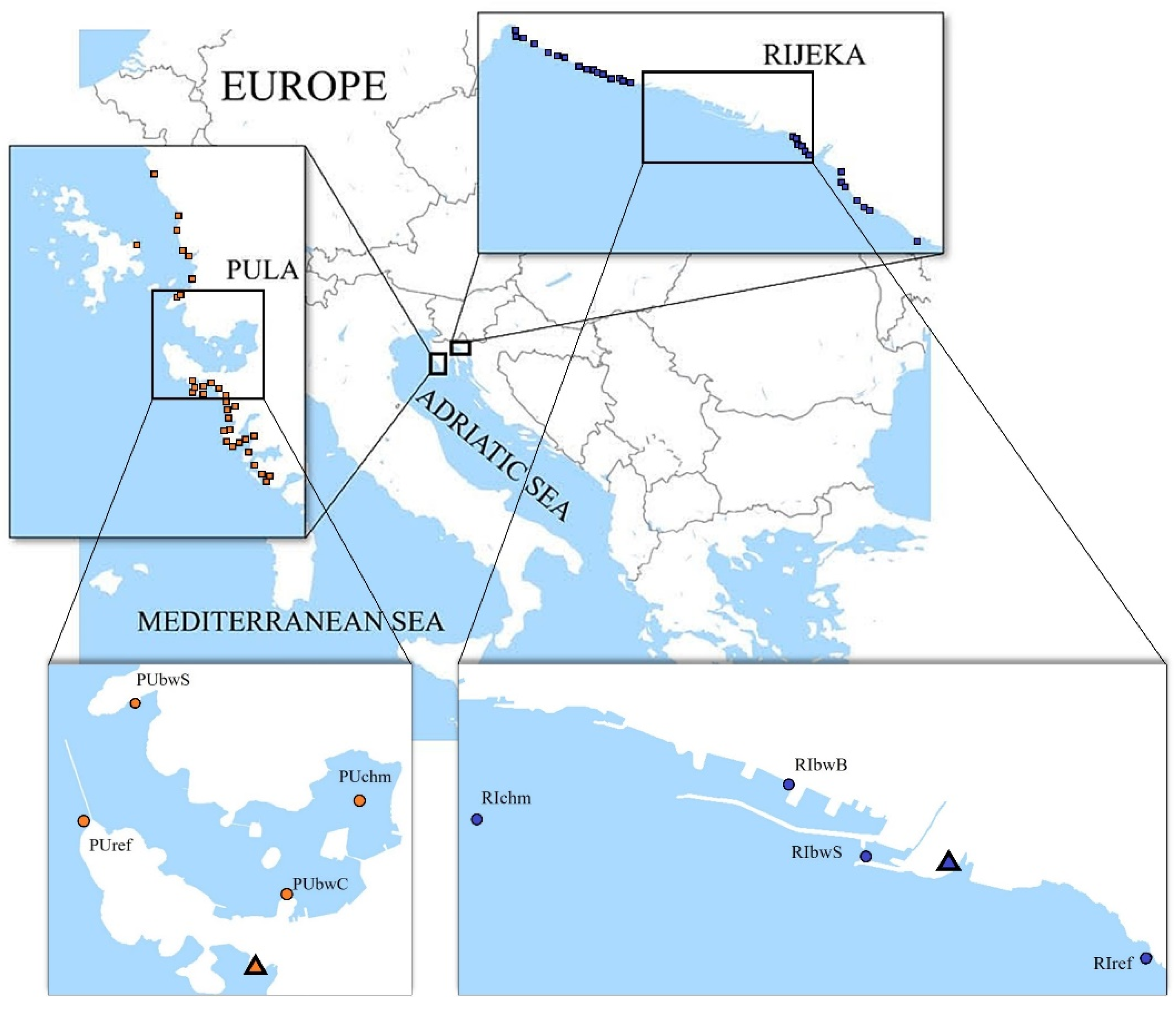


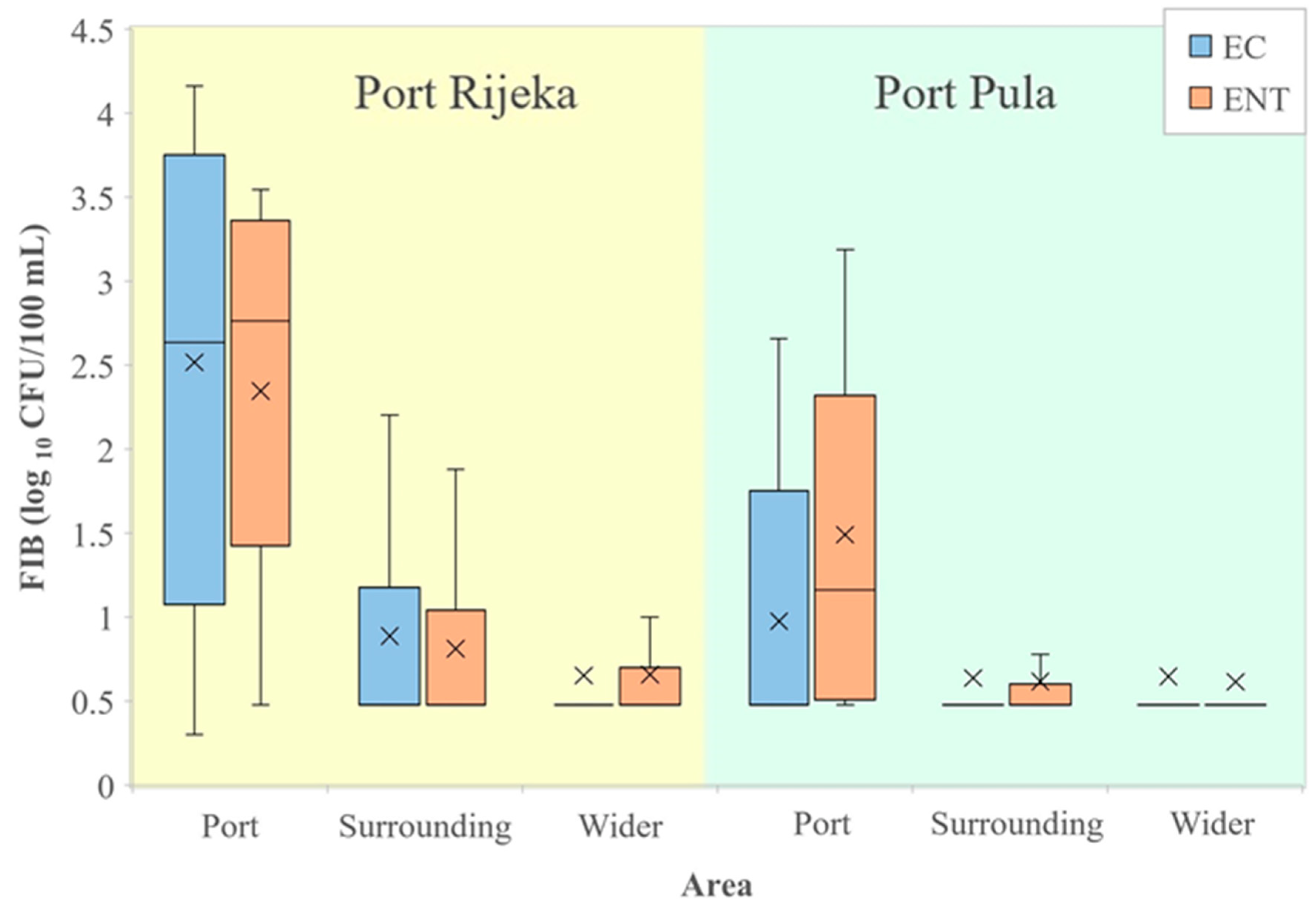

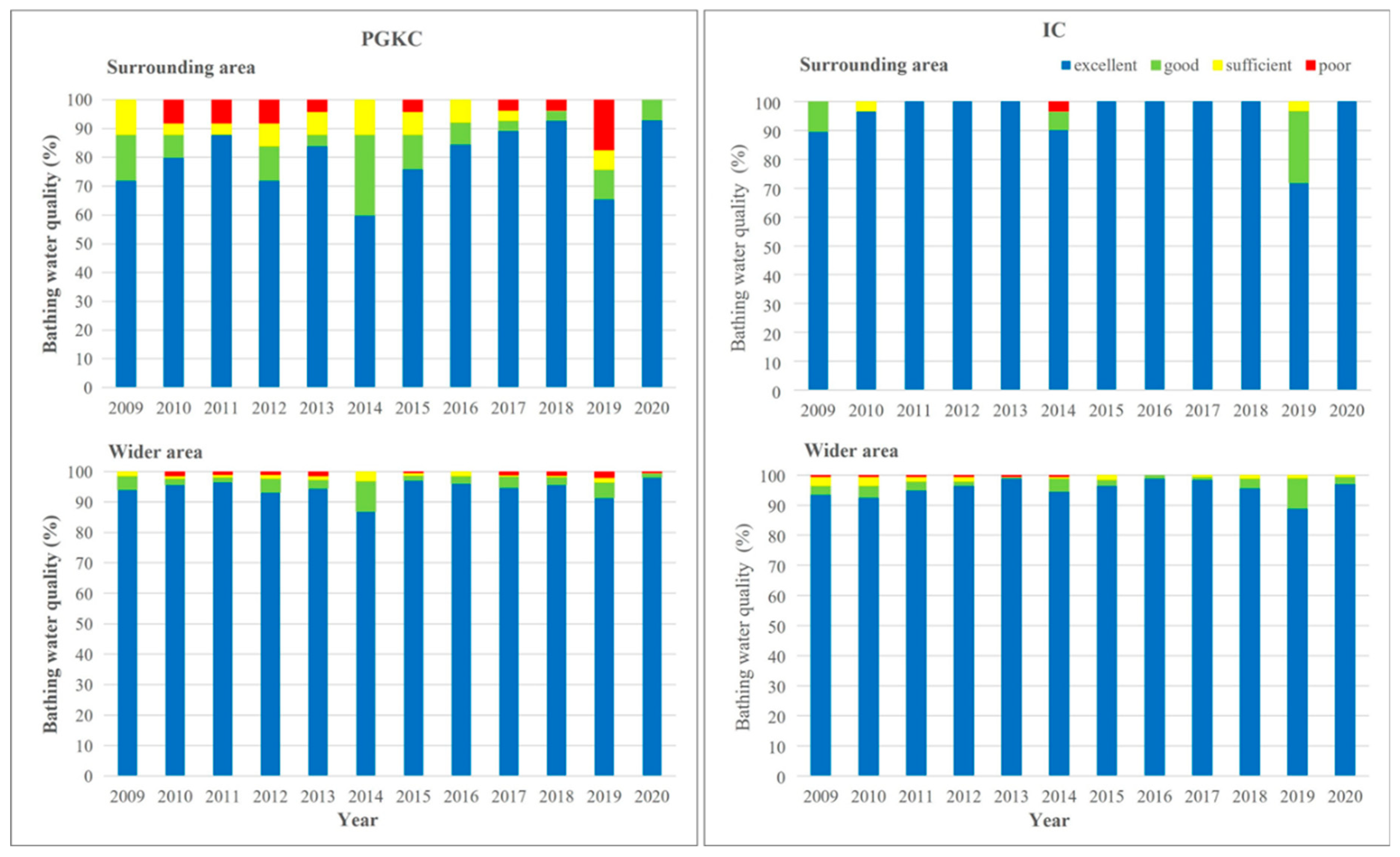

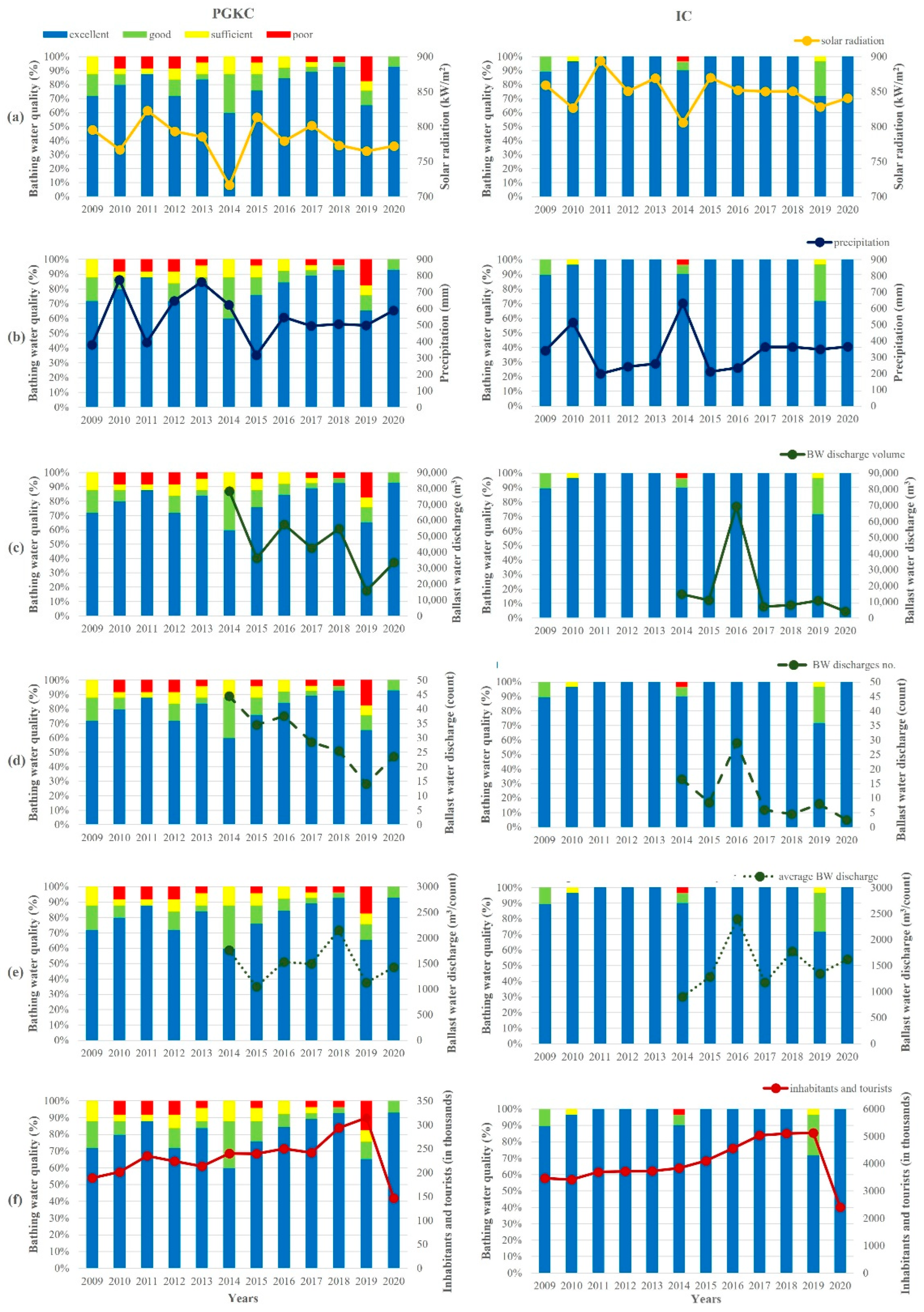

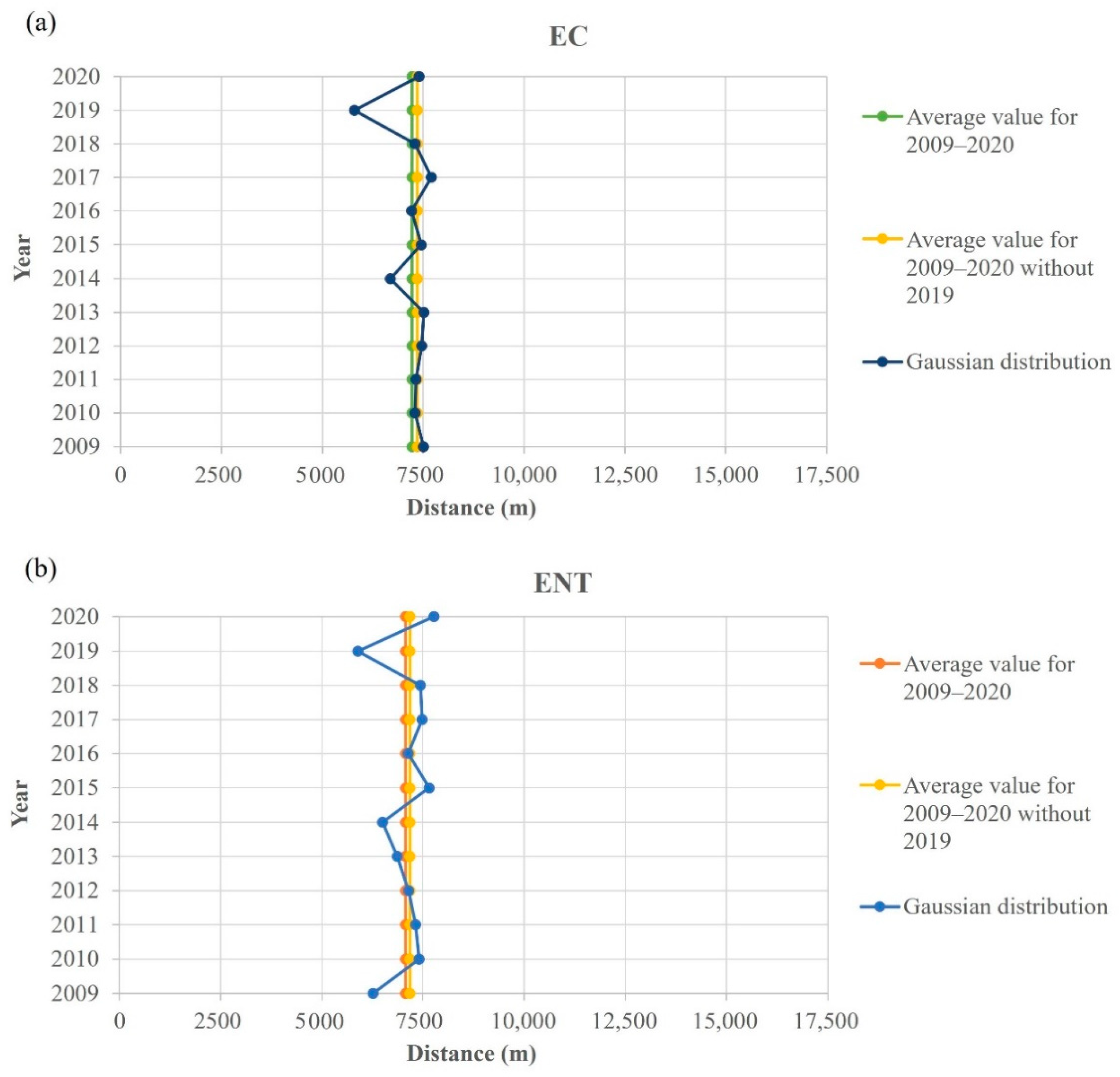
| Parameters | Excellent | Good | Sufficient |
|---|---|---|---|
| Intestinal enterococci (CFU/100 mL) | ≤100 * | ≤200 * | ≤185 ** |
| E. coli (CFU/100 mL) | ≤250 * | ≤500 * | ≤500 ** |
| (a) Seasonal presentation of E. coli (EC), intestinal enterococci (ENT), C. perfringens (CP), P. aeruginosa (PA), S. aureus (SA) determined in seawater (sw) and sediment (sed) in the ports of Pula (PUbwC, PUbwS, PUchm and PUref) and Rijeka (RIbwB, RIbwS, RIref and RIchm). Abundance in CFU/100 mL; information not available/analysis not processed (n.a.). | |||||||||||||||||||
| Bacteria | EC | ENT | CP | PA | SA | ||||||||||||||
| Season | Station | sw | sed | sw | sed | sw | sed | sw | sed | sw | sed | ||||||||
| autumn | PUbwC | 53 | 0 | 282 | 100 | n.a. | 1400 | n.a. | 0 | n.a. | 0 | ||||||||
| PUbwS | 44 | 0 | 54 | 0 | n.a. | 1600 | n.a. | 0 | n.a. | 0 | |||||||||
| PUchm | 2 | 0 | 11 | 0 | n.a. | 2100 | n.a. | 0 | n.a. | 0 | |||||||||
| PUref | 1 | 0 | 2 | 0 | n.a. | 4000 | n.a. | 0 | n.a. | 0 | |||||||||
| RIbwB | 950 | 100 | 1005 | 1100 | 85 | 3200 | 27 | 0 | 0 | 0 | |||||||||
| RIbwS | 1600 | 0 | 775 | 0 | 130 | 1400 | 25 | 0 | 0 | 0 | |||||||||
| RIchm | 19 | 0 | 35 | 0 | 5 | 3400 | 0 | 0 | 2 | 0 | |||||||||
| RIref | 4286 | 0 | 1252 | 0 | 1 | 4800 | 0 | 0 | 0 | 0 | |||||||||
| winter | PUbwC | 413 | 0 | 1100 | 100 | n.a. | 13,600 | n.a. | 0 | n.a. | 0 | ||||||||
| PUbwS | 86 | 0 | 209 | 400 | n.a. | 2000 | n.a. | 200 | n.a. | 0 | |||||||||
| PUchm | 114 | 0 | 246 | 0 | n.a. | 39,000 | n.a. | 0 | n.a. | 0 | |||||||||
| PUref | 2 | 0 | 71 | 0 | n.a. | 17,200 | n.a. | 0 | n.a. | 0 | |||||||||
| RIbwB | 13,750 | 100 | 2900 | 400 | 545 | 22,000 | 90 | 100 | 5 | 0 | |||||||||
| RIbwS | 4650 | 500 | 1180 | 2800 | 274 | 31,600 | 105 | 0 | 0 | 0 | |||||||||
| RIchm | 380 | 0 | 99 | 0 | 15 | 0 | 6 | 0 | 0 | 0 | |||||||||
| RIref | 235 | 0 | 87 | 0 | 32 | 14,400 | 1 | 0 | 0 | 0 | |||||||||
| spring | PUbwC | 1 | 0 | 192 | 0 | n.a. | 31,200 | n.a. | 0 | n.a. | 0 | ||||||||
| PUbwS | 3 | 0 | 0 | 0 | n.a. | 20,800 | n.a. | 0 | n.a. | 0 | |||||||||
| PUchm | 0 | n.a. | 6 | n.a. | n.a. | n.a. | n.a. | n.a. | n.a. | n.a. | |||||||||
| PUref | 0 | 0 | 0 | 0 | n.a. | 5200 | n.a. | 0 | n.a. | 0 | |||||||||
| RIbwB | 6900 | 1000 | 2800 | 8000 | 100 | 31,200 | 3 | 400 | 4 | 0 | |||||||||
| RIbwS | 6900 | 0 | 2500 | 600 | 0 | 20,800 | 4 | 200 | 1 | 0 | |||||||||
| RIchm | 7 | n.a. | 20 | n.a. | 8 | n.a. | 2 | n.a. | 0 | n.a. | |||||||||
| RIref | 0 | 0 | 3 | 0 | 3 | 1800 | 4 | 0 | 0 | 0 | |||||||||
| summer | PUbwC | 0 | 0 | 2 | 1600 | n.a. | 23,000 | n.a. | 0 | n.a. | 0 | ||||||||
| PUbwS | 0 | 0 | 12 | 100 | n.a. | 3600 | n.a. | 0 | n.a. | 0 | |||||||||
| PUchm | 3 | n.a. | 2 | n.a. | n.a. | n.a. | n.a. | n.a. | n.a. | n.a. | |||||||||
| PUref | 1 | 0 | 0 | 300 | n.a. | 11,000 | n.a. | 0 | n.a. | 0 | |||||||||
| RIbwB | 3100 | 100 | 3500 | 1600 | 520 | 5200 | 40 | 0 | 2 | 0 | |||||||||
| RIbwS | 400 | 100 | 1000 | 0 | 100 | 18,400 | 26 | 0 | 0 | 0 | |||||||||
| RIchm | 0 | 0 | 0 | 0 | 0 | 20,800 | 0 | 0 | 0 | 0 | |||||||||
| RIref | 2 | 0 | 100 | 4000 | 0 | 18,000 | 6 | 0 | 1 | 0 | |||||||||
| (b) Seasonal presentation of Salmonella spp. (SM), Shigella spp. (SH), A. hydrophilla (AH), A. sobria (AS), V. alginolyticus (VA), V. cholerae non-O1/non-O139 (VCn), V. fluvialis (VF), V. metschnikovii (VM) and V. parahaemolyticus (VP) determined in seawater (sw) and sediment (sed) in the ports of Pula (PUbwC, PUbwS, PUchm and PUref) and Rijeka (RIbwB, RIbwS, RIref and RIchm). Presence (•), absence (0), inconclusive results (+), information not available/analysis not processed (n.a.). | |||||||||||||||||||
| Bacteria | SM | SH | AH | AS | VA | VCn | VF | VM | VP | ||||||||||
| Season | Station | sw | sed | sw | sed | sw | sed | sw | sed | sw | sed | sw | sed | sw | sed | sw | sed | sw | sed |
| autumn | PUbwC | n.a. | 0 | n.a. | 0 | 0 | 0 | 0 | 0 | 0 | 0 | 0 | 0 | 0 | 0 | 0 | 0 | 0 | 0 |
| PUbwS | n.a. | 0 | n.a. | 0 | 0 | 0 | 0 | 0 | 0 | 0 | 0 | 0 | 0 | 0 | 0 | 0 | 0 | 0 | |
| PUchm | n.a. | 0 | n.a. | 0 | 0 | 0 | 0 | 0 | 0 | 0 | 0 | 0 | 0 | 0 | 0 | 0 | 0 | 0 | |
| PUref | n.a. | 0 | n.a. | 0 | 0 | 0 | 0 | 0 | 0 | 0 | 0 | 0 | 0 | 0 | 0 | 0 | 0 | 0 | |
| RIbwB | • | 0 | 0 | 0 | 0 | 0 | 0 | 0 | 0 | 0 | 0 | 0 | 0 | 0 | 0 | 0 | 0 | 0 | |
| RIbwS | 0 | 0 | 0 | 0 | 0 | 0 | 0 | 0 | 0 | 0 | • | 0 | 0 | 0 | 0 | 0 | 0 | 0 | |
| RIchm | 0 | 0 | 0 | 0 | 0 | 0 | 0 | 0 | 0 | 0 | 0 | 0 | • | 0 | 0 | 0 | 0 | 0 | |
| RIref | 0 | 0 | 0 | 0 | 0 | 0 | 0 | 0 | • | 0 | 0 | 0 | 0 | 0 | 0 | 0 | 0 | 0 | |
| winter | PUbwC | n.a. | 0 | n.a. | 0 | 0 | 0 | 0 | 0 | • | 0 | 0 | 0 | 0 | 0 | 0 | 0 | 0 | 0 |
| PUbwS | n.a. | 0 | n.a. | 0 | 0 | 0 | 0 | 0 | • | + | 0 | 0 | 0 | 0 | 0 | + | 0 | 0 | |
| PUchm | n.a. | 0 | n.a. | 0 | 0 | 0 | 0 | 0 | 0 | 0 | 0 | 0 | 0 | 0 | 0 | 0 | 0 | 0 | |
| PUref | n.a. | 0 | n.a. | 0 | 0 | 0 | 0 | 0 | • | 0 | 0 | 0 | 0 | 0 | 0 | 0 | 0 | 0 | |
| RIbwB | • | 0 | 0 | 0 | • | 0 | 0 | 0 | 0 | 0 | 0 | 0 | 0 | 0 | • | 0 | 0 | 0 | |
| RIbwS | 0 | 0 | 0 | 0 | • | 0 | 0 | 0 | 0 | 0 | 0 | 0 | 0 | 0 | 0 | 0 | 0 | 0 | |
| RIchm | • | 0 | 0 | 0 | • | 0 | 0 | 0 | 0 | 0 | 0 | 0 | 0 | 0 | 0 | 0 | 0 | 0 | |
| RIref | • | 0 | 0 | 0 | 0 | 0 | 0 | 0 | 0 | 0 | 0 | 0 | 0 | 0 | 0 | 0 | 0 | 0 | |
| spring | PUbwC | n.a. | 0 | n.a. | 0 | 0 | 0 | 0 | 0 | 0 | 0 | 0 | 0 | 0 | 0 | 0 | 0 | 0 | 0 |
| PUbwS | n.a. | 0 | n.a. | 0 | 0 | 0 | 0 | 0 | 0 | + | 0 | + | 0 | 0 | 0 | 0 | 0 | 0 | |
| PUchm | n.a. | n.a. | n.a. | n.a. | 0 | n.a. | 0 | n.a. | 0 | n.a. | 0 | n.a. | 0 | n.a. | 0 | n.a. | 0 | n.a. | |
| PUref | n.a. | 0 | n.a. | 0 | 0 | 0 | 0 | 0 | 0 | + | 0 | + | 0 | 0 | 0 | 0 | 0 | 0 | |
| RIbwB | • | 0 | 0 | 0 | 0 | 0 | 0 | 0 | 0 | 0 | 0 | 0 | 0 | 0 | • | 0 | 0 | 0 | |
| RIbwS | 0 | 0 | 0 | 0 | 0 | 0 | 0 | 0 | 0 | + | 0 | + | 0 | 0 | • | 0 | 0 | 0 | |
| RIchm | 0 | n.a. | 0 | n.a. | 0 | n.a. | 0 | n.a. | 0 | n.a. | 0 | n.a. | 0 | n.a. | 0 | n.a. | 0 | n.a. | |
| RIref | 0 | 0 | 0 | 0 | 0 | 0 | 0 | 0 | 0 | 0 | 0 | 0 | 0 | 0 | 0 | 0 | 0 | 0 | |
| summer | PUbwC | n.a. | 0 | n.a. | 0 | 0 | 0 | 0 | 0 | 0 | 0 | 0 | 0 | 0 | 0 | 0 | 0 | 0 | 0 |
| PUbwS | n.a. | 0 | n.a. | 0 | 0 | 0 | 0 | 0 | 0 | 0 | 0 | 0 | 0 | 0 | 0 | 0 | 0 | 0 | |
| PUchm | n.a. | n.a. | n.a. | n.a. | 0 | n.a. | 0 | n.a. | 0 | n.a. | 0 | n.a. | 0 | n.a. | 0 | n.a. | 0 | n.a. | |
| PUref | n.a. | 0 | n.a. | 0 | 0 | 0 | 0 | 0 | 0 | 0 | 0 | 0 | 0 | 0 | 0 | 0 | 0 | 0 | |
| RIbwB | • | 0 | 0 | 0 | 0 | 0 | 0 | 0 | 0 | 0 | 0 | 0 | 0 | 0 | 0 | 0 | 0 | 0 | |
| RIbwS | 0 | 0 | 0 | 0 | 0 | 0 | 0 | 0 | 0 | • | 0 | 0 | + | 0 | + | 0 | 0 | 0 | |
| RIchm | 0 | 0 | 0 | 0 | 0 | 0 | • | 0 | 0 | 0 | 0 | 0 | 0 | 0 | 0 | 0 | 0 | 0 | |
| RIref | 0 | 0 | 0 | 0 | 0 | 0 | 0 | 0 | 0 | 0 | 0 | 0 | 0 | 0 | 0 | 0 | 0 | 0 | |
| a | ||||||||||
| PARAMETERS | Water | Sediment | ||||||||
| E. coli | Int. enterococci | C. perfrigens | P. aeruginosa | S. aureus | E. coli | Int. enterococci | C. perfrigens | P. aeruginosa | ||
| Water | E. coli | 1.000 | ||||||||
| Int. enterococci | 0.886 | 1.000 | ||||||||
| C. perfrigens | 0.651 | 0.690 | 1.000 | |||||||
| P. aeruginosa | 0.459 | 0.594 | 0.584 | 1.000 | ||||||
| S. aureus | 0.530 | 0.571 | 0.517 | 0.017 | 1.000 | |||||
| Sediment | E. coli | 0.588 | 0.625 | 0.625 | 0.550 | 0.587 | 1.000 | |||
| Int. enterococci | 0.469 | 0.517 | 0.121 | 0.388 | 0.434 | 0.602 | 1.000 | |||
| C. perfrigens | 0.404 | 0.367 | −0.002 | 0.129 | 0.306 | 0.566 | 0.511 | 1.000 | ||
| P. aeruginosa | 0.507 | 0.462 | −0.096 | −0.184 | 0.256 | 0.232 | 0.441 | 0.439 | 1.000 | |
| b | ||||||||||
| PARAMETERS | Water | Sediment | ||||||||
| E. coli | Int. enterococci | E. coli | Int. enterococci | C. perfrigens | P. aeruginosa | |||||
| Water | E. coli | 1.000 | ||||||||
| Int. enterococci | 0.096 | 1.000 | ||||||||
| Sediment | E. coli | - | - | 1.000 | ||||||
| Int. enterococci | −0.152 | 0.093 | - | 1.000 | ||||||
| C. perfrigens | −0.329 | −0.029 | - | −0.162 | 1.000 | |||||
| P. aeruginosa | −0.288 | 0.380 | - | 0.421 | −0.310 | 1.000 | ||||
Publisher’s Note: MDPI stays neutral with regard to jurisdictional claims in published maps and institutional affiliations. |
© 2022 by the authors. Licensee MDPI, Basel, Switzerland. This article is an open access article distributed under the terms and conditions of the Creative Commons Attribution (CC BY) license (https://creativecommons.org/licenses/by/4.0/).
Share and Cite
Kraus, R.; Baljak, V.; Vukić Lušić, D.; Kranjčević, L.; Cenov, A.; Glad, M.; Kauzlarić, V.; Lušić, D.; Grbčić, L.; Alvir, M.; et al. Impacts of Atmospheric and Anthropogenic Factors on Microbiological Pollution of the Recreational Coastal Beaches Neighboring Shipping Ports. Int. J. Environ. Res. Public Health 2022, 19, 8552. https://doi.org/10.3390/ijerph19148552
Kraus R, Baljak V, Vukić Lušić D, Kranjčević L, Cenov A, Glad M, Kauzlarić V, Lušić D, Grbčić L, Alvir M, et al. Impacts of Atmospheric and Anthropogenic Factors on Microbiological Pollution of the Recreational Coastal Beaches Neighboring Shipping Ports. International Journal of Environmental Research and Public Health. 2022; 19(14):8552. https://doi.org/10.3390/ijerph19148552
Chicago/Turabian StyleKraus, Romina, Vanja Baljak, Darija Vukić Lušić, Lado Kranjčević, Arijana Cenov, Marin Glad, Vesna Kauzlarić, Dražen Lušić, Luka Grbčić, Marta Alvir, and et al. 2022. "Impacts of Atmospheric and Anthropogenic Factors on Microbiological Pollution of the Recreational Coastal Beaches Neighboring Shipping Ports" International Journal of Environmental Research and Public Health 19, no. 14: 8552. https://doi.org/10.3390/ijerph19148552







